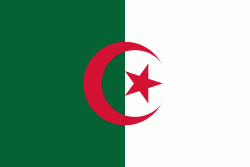Aïn El Hammam (’Aïn el Hammam)
Aïn El Hammam is a town and commune in Tizi Ouzou Province in northern Algeria.
Ain El Hammam was called Michelet during the colonial period, so called in homage to the French historian Jules Michelet. It is today an Algerian commune of the Tizi Ouzou Province, in Kabylia, located 45 km southeast of Tizi Ouzou and 95 km northeast of Bouïra. Some call it the hammam locally because being a cold thermal spring well recognized in time, it was also Soq ne Ts'latha; or "market of Tuesday", surrounded by markets known in the region like Sevt nath yahya, Souq el Djemaa, Larvaa nath Iratehen, etc. The city is located on the north slope of Djurdjura, at 1080 meters above sea level. The villages of the commune of Aïn El Hammam are built on the side of mountain, up to an altitude of 1800 meters
The commune is famous for carpet weaving in bright colors.
"Ain El Hammam" is a composite toponym, derived from the basis of the word "ain", from classical Arabic ayn and from Algerian Arabic ain, meaning "source" and corresponds for the Arabic component "el hammam" to the word "Thermal baths". The full name of the commune therefore means "source of the thermal baths".
The commune was created by the French under the name of "Michelet" in tribute to the French historian Jules Michelet. After the independence of Algeria, the commune was called Aïn El Hammam within the framework of the arabization of the names of place. However, the town (now the capital of the commune) continues to be locally named Michelet, or Michli, Michyi, which are eroded or Kabylian forms of Michelet.
Asqif n-Ṭmana is only the name of a part of this urban center with sprawling ramifications. Indeed Asqif n Tmana is the old northern entrance of the town corresponding to the ancient hamlet of Ait-Sidi-Said comprising the cemetery where is buried the bard Kabyle Si Muhand U M'hand.
Other information, refer to another former name of the region before the French colonization, which was Tala BUDHI (literary translation: the fountain of butter).
Ain El Hammam was called Michelet during the colonial period, so called in homage to the French historian Jules Michelet. It is today an Algerian commune of the Tizi Ouzou Province, in Kabylia, located 45 km southeast of Tizi Ouzou and 95 km northeast of Bouïra. Some call it the hammam locally because being a cold thermal spring well recognized in time, it was also Soq ne Ts'latha; or "market of Tuesday", surrounded by markets known in the region like Sevt nath yahya, Souq el Djemaa, Larvaa nath Iratehen, etc. The city is located on the north slope of Djurdjura, at 1080 meters above sea level. The villages of the commune of Aïn El Hammam are built on the side of mountain, up to an altitude of 1800 meters
The commune is famous for carpet weaving in bright colors.
"Ain El Hammam" is a composite toponym, derived from the basis of the word "ain", from classical Arabic ayn and from Algerian Arabic ain, meaning "source" and corresponds for the Arabic component "el hammam" to the word "Thermal baths". The full name of the commune therefore means "source of the thermal baths".
The commune was created by the French under the name of "Michelet" in tribute to the French historian Jules Michelet. After the independence of Algeria, the commune was called Aïn El Hammam within the framework of the arabization of the names of place. However, the town (now the capital of the commune) continues to be locally named Michelet, or Michli, Michyi, which are eroded or Kabylian forms of Michelet.
Asqif n-Ṭmana is only the name of a part of this urban center with sprawling ramifications. Indeed Asqif n Tmana is the old northern entrance of the town corresponding to the ancient hamlet of Ait-Sidi-Said comprising the cemetery where is buried the bard Kabyle Si Muhand U M'hand.
Other information, refer to another former name of the region before the French colonization, which was Tala BUDHI (literary translation: the fountain of butter).
Map - Aïn El Hammam (’Aïn el Hammam)
Map
Country - Algeria
 |
|
| Flag of Algeria | |
Algeria produced and is linked to many civilizations, empires and dynasties, including ancient Numidians, Phoenicians, Carthaginians, Romans, Vandals, Byzantines, Umayyads, Abbasids, Rustamids, Idrisids, Aghlabids, Fatimids, Zirids, Hammadids, Almoravids, Almohads, Zayyanids, Spaniards, Ottomans and the French colonial empire, with the latter expanded into its present-boundaries. After 132 years of being part of France, tensions between France and the local Algerian populace led to the start of the Algerian War which concluded with Algeria obtaining its independence on 5 July 1962 with the establishment of the People's Democratic Republic on 20 September of that year.
Currency / Language
| ISO | Currency | Symbol | Significant figures |
|---|---|---|---|
| DZD | Algerian dinar | دج | 2 |
| ISO | Language |
|---|---|
| AR | Arabic language |















